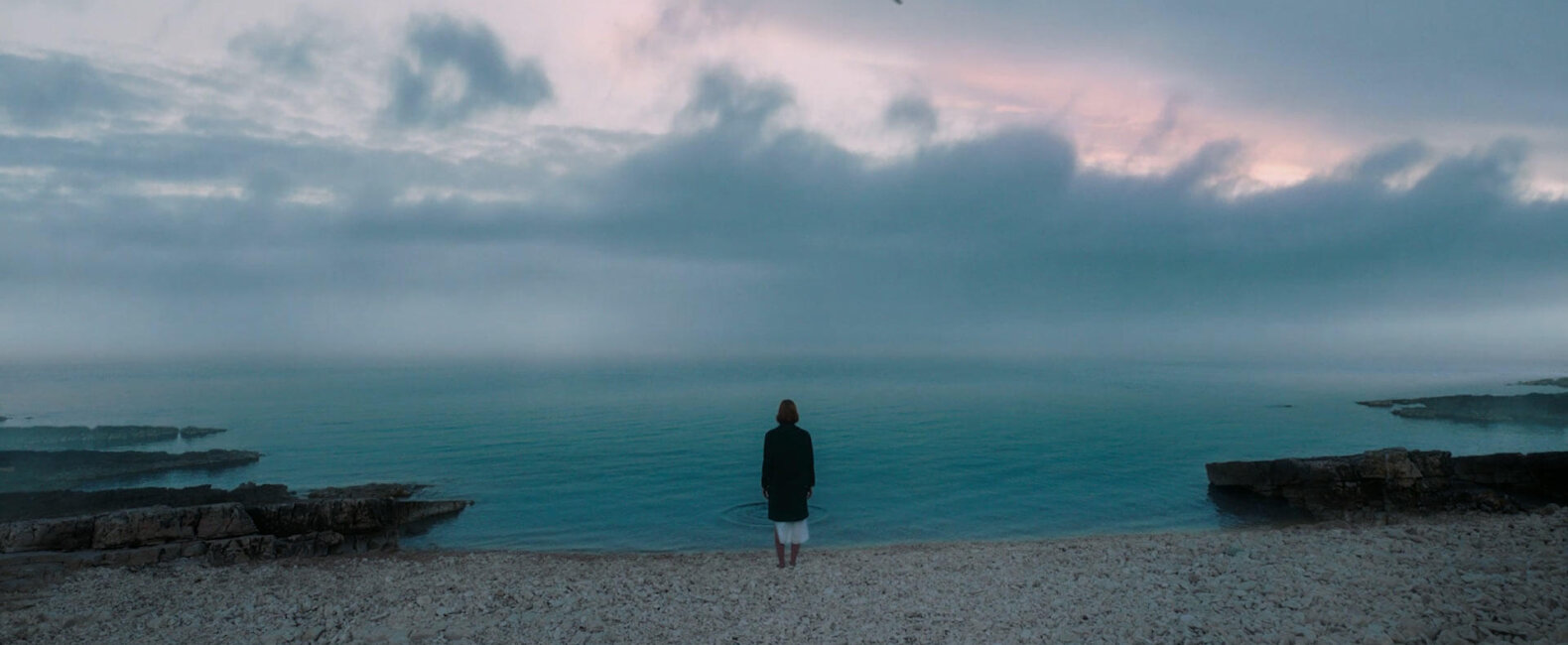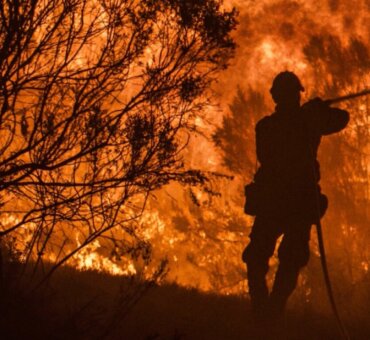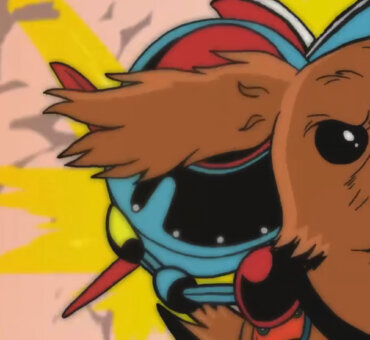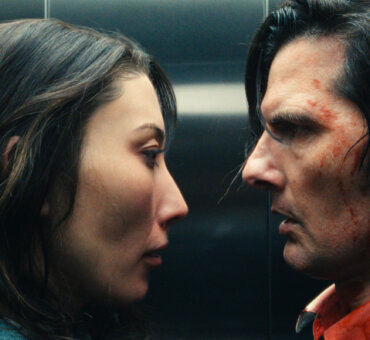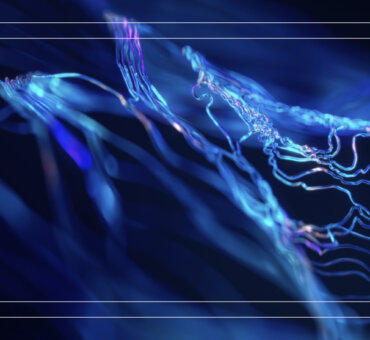Title sequences serve an entirely different purpose than the introduction of a show. They’re most likely compared to a book’s forward, where an outsider offers a rich, unexpected perspective on a work of art. It’s tangentially related but exists in a parallel universe.
Editor Doron Dor and directors Heidi Berg and Felix Soletic live for this moment—the opportunity to give the audience a glimpse into something deeper than plot and storylines. In their work on Ratched, they’re giving viewers a glimpse into madness.
“Every time I’m doing a title sequence, there’s this grand scheme to—yes, use the themes of the show—but also to create this additional container that holds metaphor, archetype, character, and objects which the viewer can project themselves onto,” Heidi said.
If you’re confused, just watch the title sequence. A close collaboration between TV creator Ryan Murphy, EP Alexis Martin Woodall, and the team at Elastic, the title sequence is crazy, hypnotic, haunting, and beautiful. After watching it, keep it open so you can follow our conversation with Heidi, Felix, and Doron as they break down key moments from this project.
Here’s the Ratched title sequence, beat by beat.
0:00-0:08 | Beach
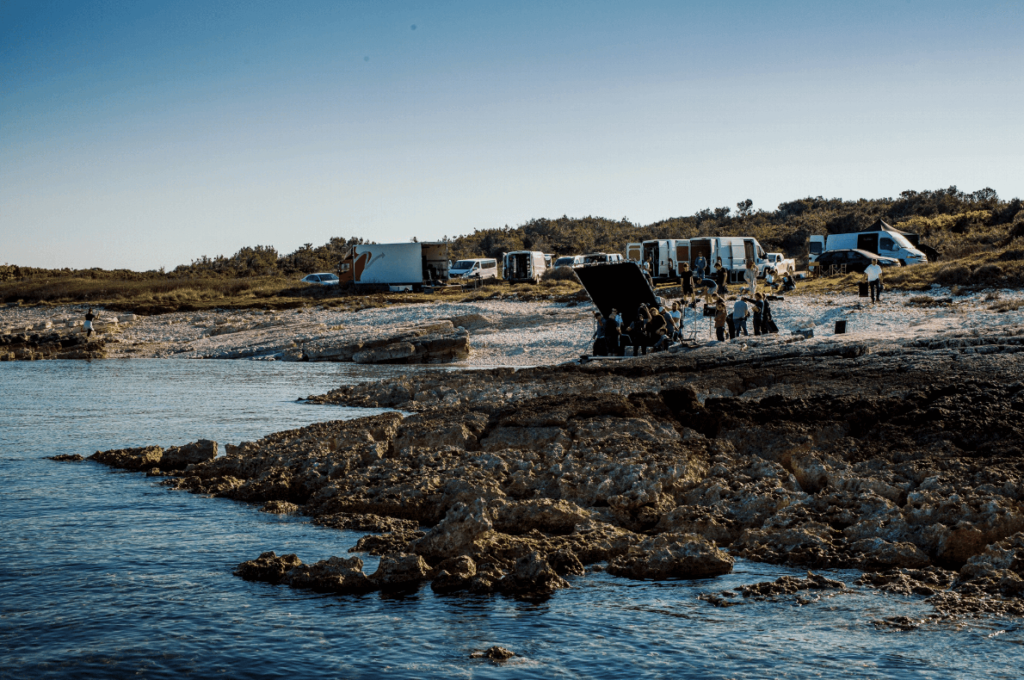
Heidi Berg: We were all thinking, ‘How in the hell are we going to shoot this?’ Location costs in Los Angeles (or anywhere in the United States) are a nightmare. A line producer at Elastic, Milena Milicevic, had worked with Division, a production company in Slovenia. We reached out to them, and they came back with some mind-blowing locations.
It took us a full day just to decide on the forest because the forests in Ljubljana were all just so beautiful. When we saw the ballroom, we were sold. I don’t think I’ve ever received location photos in a deck like that and just immediately loved it. Our only hold-up was probably the beach. The beach was a bit of a nightmare.
Felix Soletic: I think we drove across all of Slovenia looking for the beach and then ended up having to venture further into Croatia, which was nice for me because I’m Croatian. We needed a sense of openness and this endless horizon line in front of us, but with enough clearance behind us so we could actually make wide shots. A lot of locations in Slovenia had these big cliffs that would drop off. So we went through quite a few of them and climbed a bunch of hills.
Heidi: Oh, my God. Do you remember that one? We had to climb up a cliffside with a bunch of heavy-ass backpacks. I was fully sweating through all of my clothing. When we finally got down there, Felix was saying, ‘Nope.’ I had a mini-meltdown because we were supposed to shoot the next day. We could not get the camera back far enough to do a wide shot, and it was just panic mode. I think we drove to six different beaches that day. It was crazy.
Doron Dor: This is a good example of falling in love with the rip because in the rip we had a really amazing Big Sur wide shot. And I think Ryan [Murphy] reacted to that shot very well. At that point, it’s branded in your mind. And we were really scared because it’s the opening and it doesn’t feel as big and open as in the rip. We ended up finding something slightly different. But, the more we worked with it, the more I thought this beach could definitely work. It’s about starting with a clean slate. The rip was great, but we’re not trying to imitate rip.
0:19 | Eyeball
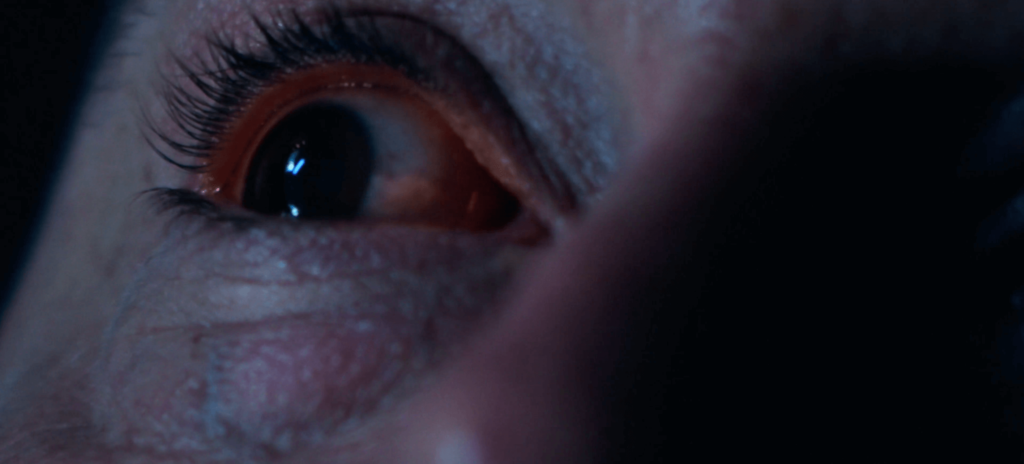
Filmsupply: Any Easter eggs you want to give away?
Heidi: Okay. We’ll give you the eyeball [laughs]. So the shot of the eyeball, with the eyes moving side to side, all bloodshot is the EP of Elastic, Luke Colson. He’s one of the people that we took downstairs and tortured for a few hours.
Felix: By the very end we needed to inject just a tiny bit more horror into it. The three of us got together and did a little pickup shoot in the warehouse below Elastic. We grabbed any and all volunteers who were willing to be shot and tortured in front of a camera [laughs]. The eyeball is my favorite. It ended up working perfectly because I think there was a glimmer of truth in that shot.
The panic was real.
Felix: All of the volunteers were thinking, ‘What did I sign up for?’ [laughs]
0:05-1:03 | String
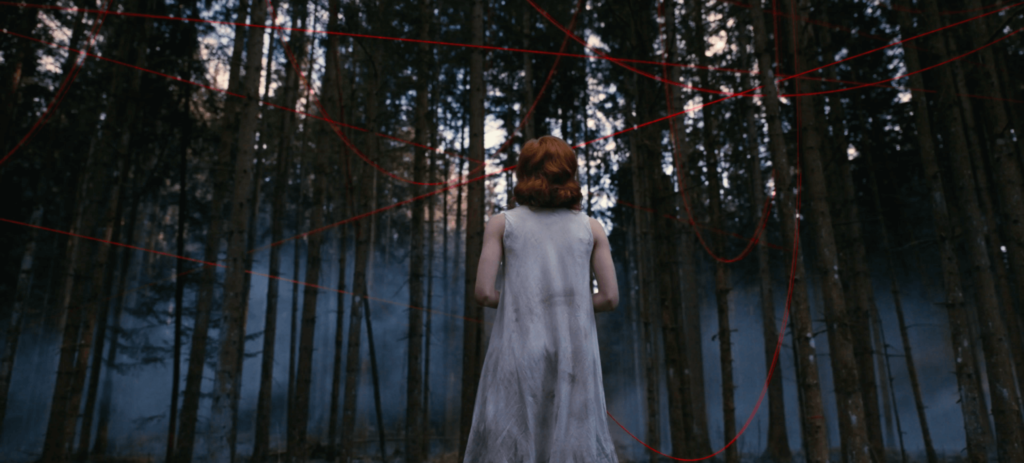
Felix: This concept really built on itself over time. In the initial pool of ideas, this theme of Ariadne’s Thread started coming into the conversation. In the initial pitch treatment, there were several ideas we were feeling pretty strongly about. But, sometimes you pair these concepts with some references and talk through them, and something will jump out, even if the concept around it is still a work in progress. When Ryan saw this thread, it really stuck with him.
It was always this idea of a character who was constantly shifting, someone we could place ourselves into as a viewer. They were trudging down this path laid before them, and it was really a trap all along, almost a loop—it’s a prison of your own madness.
Heidi: When we started thinking about the hospital or other locations, we started thinking about it as a maze. We’re thinking about being trapped inside the labyrinth. The psychiatric hospital becomes a metaphor for the mind—where you are lured into your unconscious and eventually into madness.
There’s this interplay between hope and fear—following a thread, you believe you’re moving towards a resolution or a way out. There’s this hope amongst the chaos the whole time, but going back to what Felix referenced, you’re just in a loop. Things are the same, but they’re shifting. You’re getting deeper, and it’s getting weirder. In the end, as you follow the thread, that hope gets severed. We loved that. There’s no way out.
0:32 and 0:40 | Balcony Shot and Deer Eye
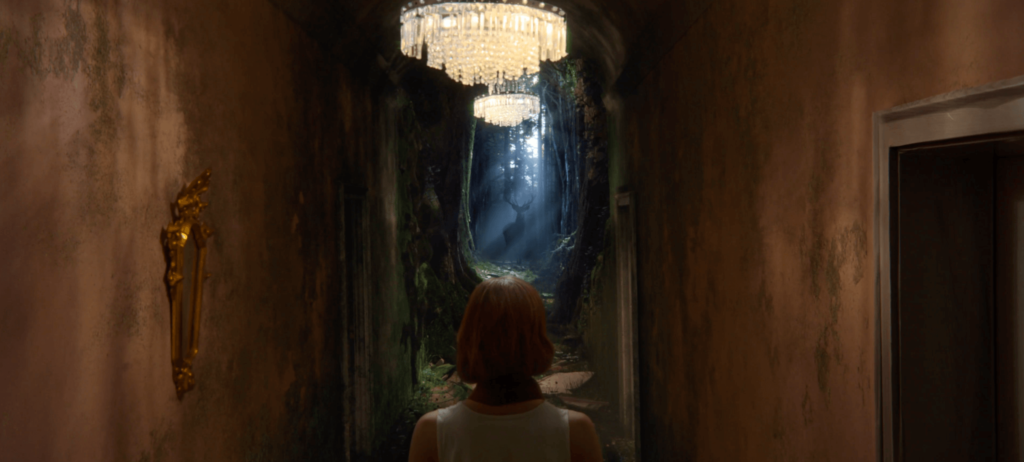
Heidi: I want to speak to the tone a little. We were working with just the scripts and Doron came in to flesh out the tone because we didn’t have any dailies. Doron came in and started pulling additional selects from YouTube, Vimeo, and other films to put a tone piece together. I’m curious to hear how Doron felt it guided things.
Doron: Well, the guide itself came from Heidi and Felix. At this point, they are the closest thing to showrunners, and you’re having a conversation, ‘What do you imagine it to be? What do you want it to be?’ Essentially, we’re talking about our best-case scenario. Specifically on rips, on mood pieces, it’s important to have the right material and the right colors. Then, it’s a matter of narrowing it down so it’s cohesive.
It was about picking the right moment and selecting a lot of moments that resonated. The guidelines they gave me had enough there to create a mood piece that we all really liked and stood by itself.
Heidi: What you did with the shots that were selected deeply informed the choreography of our camera when we went and shot it. I don’t think we would have had as much dynamic movement and flow taking place if we hadn’t pre-established that and worked it out within the style piece. In the end, our DP Vladan Janković crafted the shots beautifully.
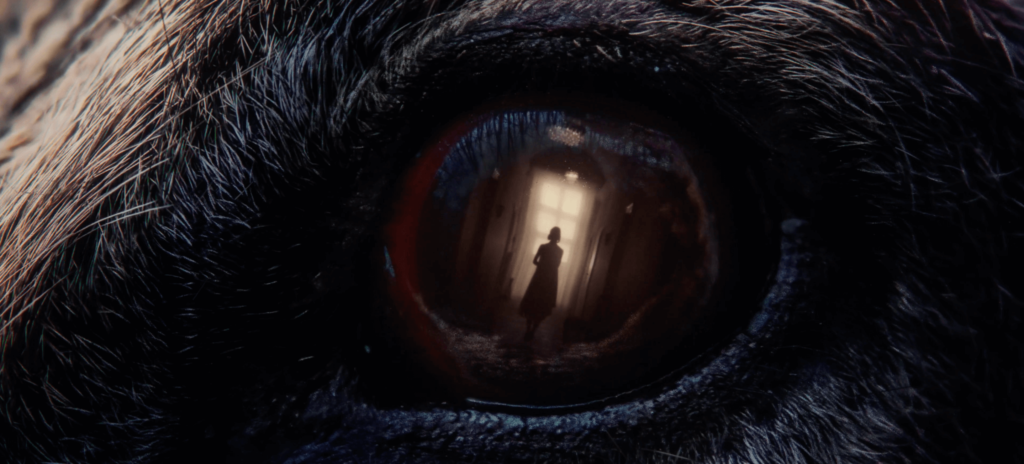
Felix: When you see a string of images this early in the process, even as a mood piece or of footage from other movies, there’s something that instantly clicks. What will work and what won’t? It’s still very early in the process, but what Doron did was give us a glimmer of how the final thing could end up being and its DNA. Now, I can at least see a glimmer of the final piece at the end of the tunnel that definitely helps mentally and emotionally.
Heidi: The core theme we were trying to get to was this concept of what is madness. What is it to lose oneself in the mind? You feel drawn in watching it. It gives you that sense of losing your mind, and that was a huge thematic element that came into play for the main title.
What specifically did you use for the rip?
Heidi: There were a few shots in there from A Cure For Wellness. There was this shot from the rip where the camera pushes through a window and tilts down to see a few patients from a mezzanine. We loved the reference for that shot so much that when we went on location in Slovenia, I remember Felix and I were in this ballroom area, and we ended up shooting the balcony shot. We’ve got one of our characters on the periphery on the left side, and we kind of pushed past him and tilted down to find our lead character following the string, and she exits. Moments like that, where the camera moves and is so dynamic and beautiful, play with perception and disorientation. There’s also a shot of a deer eye in A Cure for Wellness that inspired us to introduce the deer, a mythical symbol—the call of the inner world, of the unconscious. They lead you where you need to go.
0:42-0:54 | Forest
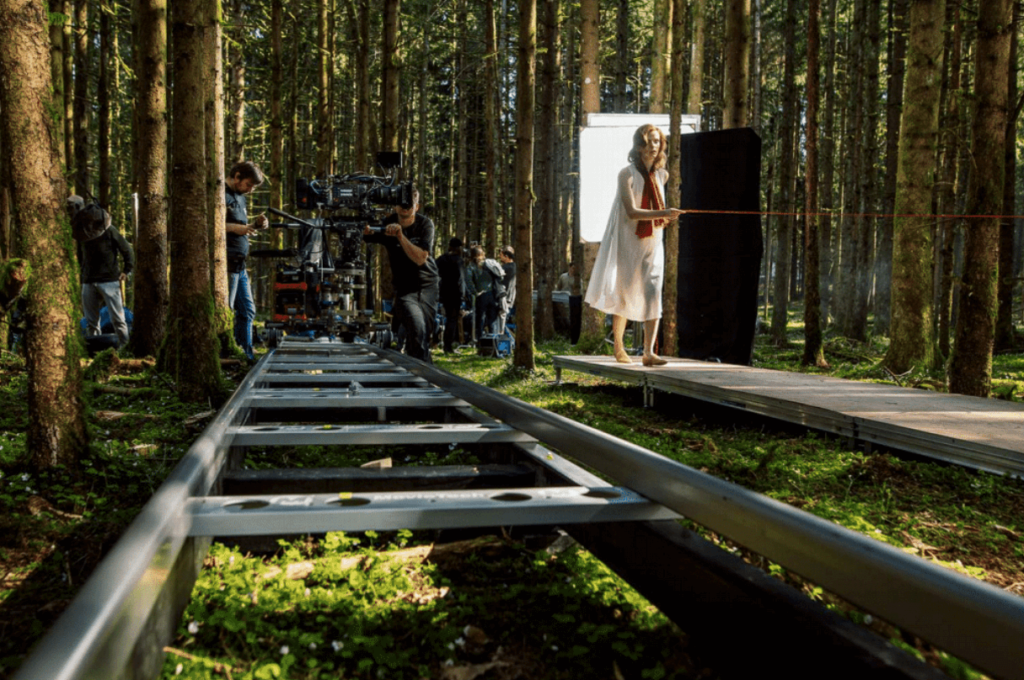
Heidi: I whined about the green screen for about an hour, because I didn’t want to do it, and Felix had to talk me off the ledge [laughs]. Felix, do you want to talk about that shot a little bit?
Felix: Heidi and I have worked so well over the years because I was obsessed with CG, and Heidi’s obsession with shooting live-action. When the two of us are on the same project together, it ends up being this beautiful, weird hybrid. We both want to push each shot into our own world because we feel that we can control it more.
This transition was a bit of a challenge. We knew we wanted to switch between these three different settings, these three different sets. We loved match-cutting, but we felt like there should be another moment towards the very end where we go through the asylum the second time, and it’s destroyed, things are obviously askew and something is happening.
In the second moment where we returned to the forest, that was really kind of a sign of our reality shifting, where things have kind of taken a turn. You’re not necessarily clued into the fact that it’s a trap that’s laid out for you, but you get a sense that there’s a menacing quality to it. From a conceptual standpoint, that’s what was going on, and from a visual standpoint, it was nice to bridge to two locales in one shot.
You see this wall eroding, creating a natural gradient, and this forest that we saw before is now much darker and more sinister. It was definitely one of those shots where you second guess why you did it during late nights at the studio—especially, six months into doing roto, comp, and sculpting the walls, making CGI, and tracking these two plates so they feel natural together. But, when it all sits together, there’s this fantastical moment that adds to the overall strangeness of the piece.
Heidi: We didn’t have a lot of time to shoot in the woods and we’re matching this plate that we shot on a different day, on a green screen, within the ballroom. On the previous day, we shot our main character in the woods with this beautiful light. We had to check the lighting and check her positioning because she couldn’t go from super hunched over to suddenly straight up.
It was a continuity nightmare at that moment. We have a behind-the-scenes photo of Felix and me watching that moment on the green screen and people behind us are stressed because we are losing light and time.
Felix: And again, Doron helped us so immensely with this shot. There’s this moment where we transition, and Doron found that perfect overlap. We put all the CG behind it, and it still looked wrong. And then Doron said, ‘All right, we just need to slip the two plates by a few frames.’ And suddenly, it looked correct!
Doron: It was the moment of the hand lifting and grabbing the string. It was a great transition point where we had the tree come in to match those two moments. From the storyboard, there were transition moments that we knew about, and some of them were not super easy, but you could see them. You can see the camera’s going to rotate, it’s going to move to this scene. This one was just about getting the flow of those two shots. It’s like a magic trick, ‘Don’t look here, look here.’
Felix: The shot right after it, where the character was following changes completely, I remember Doron tapped my shoulder and said, ‘I want to show you something.’ We went to his computer, and he played it, and I freaked out. It might be my favorite moment because it’s a sign of things taking a turn for the strange and the weird, which we desperately need.
0:58-1:08 | Dark Room
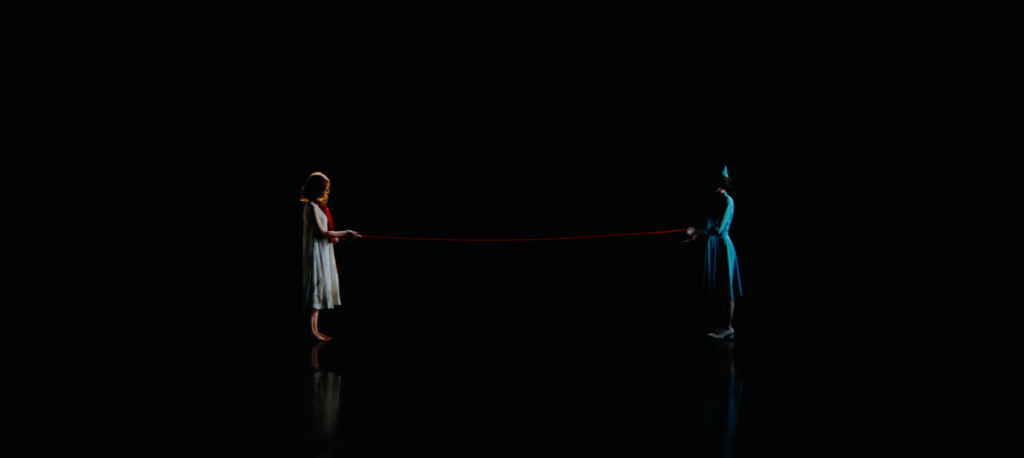
Doron: There are a lot of tracking shots following people. We really looked into following people, a lot of close-ups of expressions on people’s faces that were very complex. It was about showing the duality between the personalities.
Heidi: You said the magic word, Doron, duality. There are a few shots from Jonathan Glazer’s Under The Skin, where she is running into the woods and the camera is pushing in. I remember we were obsessed with that shot of her running, and also the void at the end. We loved getting into that space of, ‘Now you’re in it; you’re right at the center of your madness.’
Felix: Nothing but Sarah Paulson with a pair of scissors [laughs].
Doron: At that point, it’s game over.
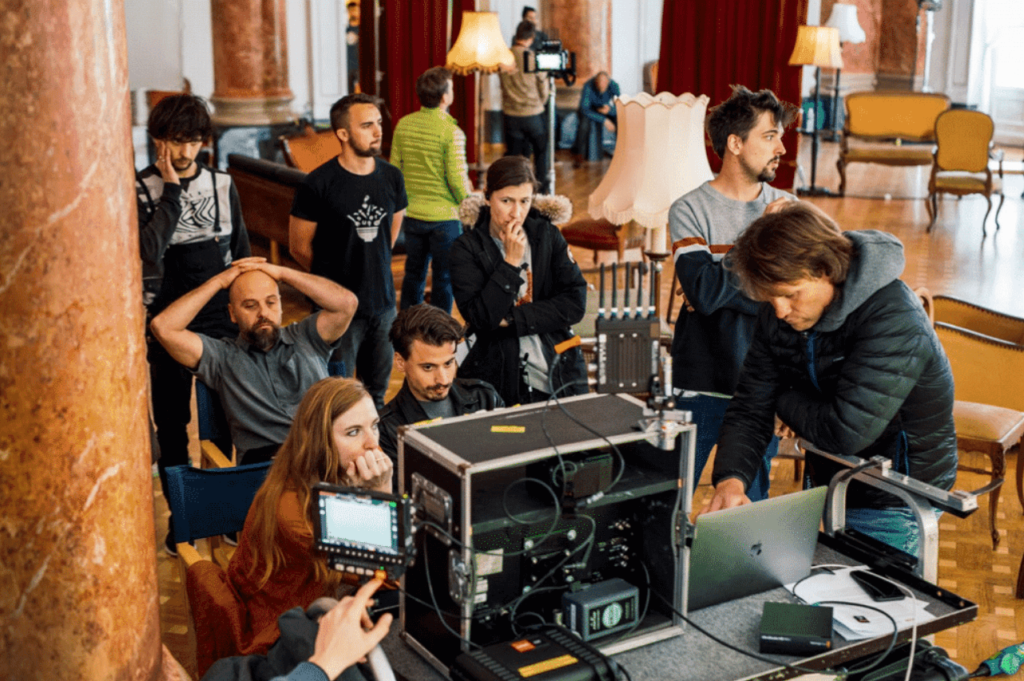
Read our conversation with DP/Editor Nik Kleverov as he takes us beat by beat through the Narcos title sequence.
